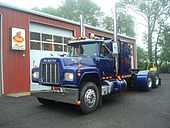Mack R series
| Mack R Model | |
|---|---|
 | |
| Overview | |
| Manufacturer | Mack Trucks |
| Production | Worldwide |
| Model years | 1966-2005 |
| Assembly |
Allentown, Pennsylvania Hayward, California |
| Body and chassis | |
| Class | Class 8 truck |
| Body style | Truck (bonneted cab) |
| Layout |
4x2 4x4 6x4 6x6 |
| Related |
Mack U Series Mack DM Series Mack Super-Liner |
| Powertrain | |
| Engine |
Diesel Gasoline |
| Transmission |
Mack / Fuller (manual) Allison (automatic) |
| Chronology | |
| Predecessor | Mack B Model |
| Successor | Mack Granite |

.jpg)
The Mack R Model was a Class 8 heavy-duty truck first introduced in the early 1960s by Mack Trucks, to replace the very successful Mack B Model.[1] Its production ran for 40 years until the RD model was discontinued in 2002 and the RB and DM models were discontinued in 2005. The first R models introduced were powered by Mack Thermodyne diesel and gasoline engines. In 1973 the R cab was given a makeover to include a deeper rear wall for more room and a new dashboard design.
Model numbers & letters
- R - Standard model
- RB - Set back front axle (except in New Zealand - see NZ Mack RB)
- RD - Heavy Duty R
- RM - 4x4 Municipal/maintenance chassis
- RMM - 6x6 Municipal/maintenance chassis
- RS - Western R series, S stands for steel frame
- RL - Western R series, L stands for Aluminum frame
- RW - Western series, replaced by the Mack Super-Liner
- Chassis numbers (GVW Rating):
- 4xx -
- 6xx -
- 7xx -
- 8xx -
Note: the xx is the place holder for the engine code.
- Suffix letters:
- T - Tractor
- S - Six wheel chassis
- L - Light weight components
- X - Extreme duty
U and DM series
The “U” and “DM” series were modifications of the “R” series. A short hood, and the shorter “bumper to back of cab” distance, made them useful in strait trucks and in semi-tractors used in congested cities, but caused the engine to intrude into the passenger compartment. To compensate the cab was offset to the left, the engine “doghouse” intruded into the passenger footwell but left the driver’s position intact. The U was basically a short R, while the DM was an extra heavy duty version of the U often used in 6X4 construction trucks. Like the RMM, the DMM was all wheel drive, but had not only a short hood/offset cab, but also a set back front axle, requiring a model specific fiberglass hood/fender arrangement.[2][3]
Engine codes
Maxidyne, Thermodyne, Econodyne
EN -Engine (gas) END-Engine Diesel ENDT-Engine Diesel Turbocharged
By 1988 the numbering system had changed slightly. The prefix “D" and "T”, no longer needed as all engines were Diesel and turbocharged, were discarded, as was the "N". The prefix “M” was for “Maxidyne” wide power range models, C was for California certified engines. A “6” was for the 672 c.i. I6, “9” was for the 998 c.i. V8, in 1987 the "7” 728c.i. I6 was introduced. The next three digits were the horsepower rating of the engine, and an “L” suffix indicated a low speed model. An example would be the ENDT673 and later E6-200 being similar engines.[1][4] [5]
E6-676 Ci Inline 6 E7-728Ci Inline 6 E9-998 Ci V8
95 - ENDT865 V8
See also
- Mack Trucks
- List of Mack Trucks Products
References
- ↑ 1.0 1.1 Corporate History - Mack Trucks.com
- ↑ Warth, Thomas E. (1998). Mack Trucks Photo Gallery. Iconografix. pp. 196–199, 201–204, 207–210, 218. ISBN 1-882256-88-3.
- ↑ Operators Handbook-DM, DMM, U Series. Mack Trucks. 1988. pp. 2–5.
- ↑ Operators Handbook(88) p.60
- ↑ Operators Handbook-R Series. Mack Trucks. 1996. pp. 6, 9.
| ||||||||